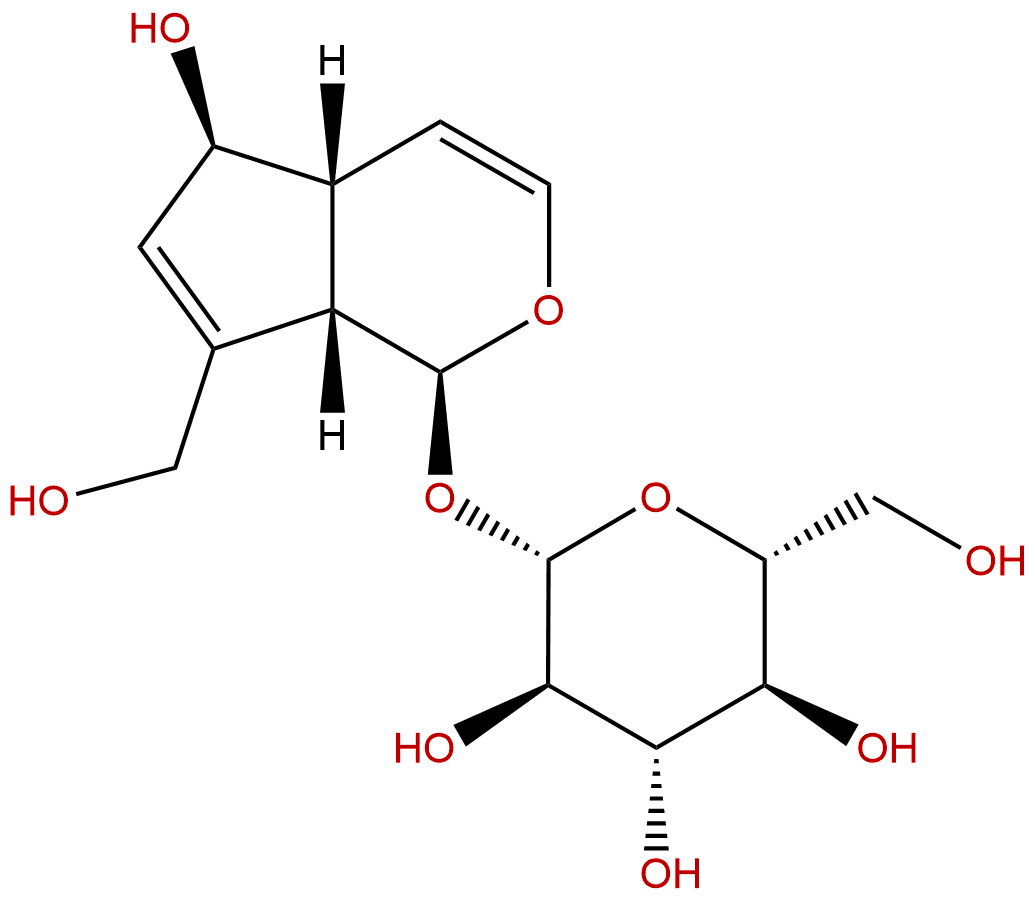
AucubinCAS No.:479-98-1
|
||||||||||
 |
|
|
||||||||

| Catalogue No.: | BP0220 |
| Formula: | C15H22O9 |
| Mol Weight: | 346.332 |
Product name: Aucubin
Synonym name: Aucuboside; Rhinanthin; Rhimantin
Catalogue No.: BP0220
Cas No.: 479-98-1
Formula: C15H22O9
Mol Weight: 346.332
Botanical Source: Eucommia u2moides Oliv.
Physical Description:
Type of Compound: Iridoids
Purity: 95%~99%
Analysis Method: HPLC-DAD or/and HPLC-ELSD
Identification Method: Mass, NMR
Packing: Brown vial or HDPE plastic bottle
Storage: Store in a well closed container, protected from air and light. Put into refrigerate or freeze for long term storage.
Whenever possible, you should prepare and use solutions on the same day. However, if you need to make up stock solutions in advance, we recommend that you store the solution as aliquots in tightly sealed vials at -20℃. Generally, these will be useable for up to two weeks.
The product could be supplied from milligrams to grams
Inquire for bulk scale.
Description:
Aucubin is an iridoid glycoside with a wide range of biological activities, including pancreas-protective, chondroprotective, antispasmodic, liver-protective, anti-inflammatory, anti-microbial, antioxidant, anti-algesic as well as anti-tumor activities. Aucubin prevents neuronal death in the hippocampal CA1 region in rats with diabetic encephalopathy, it also has protective effects on H2O2-induced apoptosis in PC12 cells. Aucubin may improve obesity-induced atherosclerosis by attenuating TNF-α-induced inflammatory responses. Aucubin suppresses hepatitis B viral DNA replication in vitro.
References:
Exp Neurobiol. 2014 Sep;23(3):238-45.
Aucubin promotes neurite outgrowth in neural stem cells and axonal regeneration in sciatic nerves.
Aucubin is an iridoid glycoside with a wide range of biological activities, including anti-inflammatory, anti-microbial, anti-algesic as well as anti-tumor activities. Recently, it has been shown that Aucubin prevents neuronal death in the hippocampal CA1 region in rats with diabetic encephalopathy. In addition, it has protective effects on H2O2-induced apoptosis in PC12 cells.
METHODS AND RESULTS:
We have shown here that Aucubin promotes neuronal differentiation and neurite outgrowth in neural stem cells cultured primarily from the rat embryonic hippocampus. We also investigated whether Aucubin facilitates axonal elongation in the injured peripheral nervous system. Aucubin promoted lengthening and thickness of axons and re-myelination at 3 weeks after sciatic nerve injury.
CONCLUSIONS:
These results indicate that administration of Aucubin improved nerve regeneration in the rat model of sciatic nerve injury, suggesting that Aucubin may be a useful therapeutic compound for the human peripheral nervous system after various nerve injuries.
Cytokine. 2013 Jun;62(3):407-12.
Aucubin, a naturally occurring iridoid glycoside inhibits TNF-α-induced inflammatory responses through suppression of NF-κB activation in 3T3-L1 adipocytes.
Obesity is closely associated with a state of chronic, low-grade inflammation characterized by abnormal cytokine production and activation of inflammatory signaling pathways in adipose tissue. Tumor necrosis factor (TNF)-α is chronically elevated in adipose tissues of obese rodents and humans. Increased levels of TNF-α are implicated in the induction of atherogenic adipokines, such as plasminogen activator inhibitor (PAI)-1, adipose-tissue-derived monocyte chemoattractant protein (MCP)-1, and interleukin (IL)-6. Aucubin, an iridoid glycoside existing in medicinal plants, has been reported to show an anti-inflammatory activity by suppression of TNF-α production in murine macrophages.
METHODS AND RESULTS:
The present study is aimed to investigate the effects of Aucubin on TNF-α-induced atherogenic changes of the adipokines in differentiated 3T3-L1 cells. Aucubin significantly inhibited TNF-α-induced secretion and mRNA synthesis of the atherogenic adipokines including PAI-1, MCP-1, and IL-6. Further investigation of the molecular mechanism revealed that pretreatment with Aucubinsuppressed extracellular signal-regulated kinase (ERK) activation, inhibitory kappa Bα (IκBα) degradation, and subsequent nuclear factor kappa B (NF-κB) activation.
CONCLUSIONS:
These findings suggest that Aucubin may improve obesity-induced atherosclerosis by attenuating TNF-α-induced inflammatory responses.
Res Commun Mol Pathol Pharmacol. 1998 Nov;102(2):189-204.
Liver-protective activities of aucubin derived from traditional oriental medicine.
The iridoid glycosides including Aucubin (AU), catalpol (CA), swertimarin (SW), and gardenoside (GA) are frequently found as natural constituents of many traditional oriental medicinal plants including Chinese herbs. Among these iridoid glycosides, AU was systematically studied for its potent liver-protective activities using experimental systems of hepatic damage. AU showed high liver-protective activity against carbon tetrachloride-induced hepatic damage in mice. Also AU showed significant protective activity against alpha-amanitin-induced hepatic damage in mice, and it prevented a depression of liver RNA biosynthesis caused by alpha-amanitin administration. Potent antidotal effects on mushroom poisoning in beagle dogs ingested with aqueous extract of Amanita virosa was observed; beagle dogs completely survived, even when AU administration was withheld for half an hour after mushroom poisoning. In addition, AU was found to suppress hepatitis B viral DNA replication in vitro. Conversion of AU to its aglycone form appeared to be a prerequisite step for an exhibition of such antiviral activity.
Int Immunopharmacol. 2015 Feb;24(2):408-15.
Aucubin prevents interleukin-1 beta induced inflammation and cartilage matrix degradation via inhibition of NF-κB signaling pathway in rat articular chondrocytes.
Proinflammatory cytokine interleukin-1β (IL-1β) plays a crucial role in the pathogenesis of Osteoarthritis (OA) by stimulating several mediators contributed to cartilage degradation. Aucubin, a natural compound derived from plants which has been shown to possess diverse biological activities including anti-inflammatory property, may benefit the IL-1β stimulated chondrocytes.
METHODS AND RESULTS:
The present study was aimed to investigate the effects of Aucubin on IL-1β stimulated rat chondrocytes. Rat chondrocytes were cultured and pretreated with Aucubin (1, 10, 20, 50μM), and then stimulated with or without IL-1β (10ng/ml). Gene and protein expression of MMP-3, MMP-9, MMP-13, cyclooxygenase-2 (COX-2), inducible nitric oxide synthase (iNOS) was determined by real-time PCR and Western blotting respectively. Nitric oxide (NO) production was quantified by Griess reagent. Phosphorylation and nuclear translocation of p65 were detected by western blotting and immunofluorescence, respectively. We found that Aucubin significantly reversed the elevated gene and protein expression of MMP-3, MMP-9, MMP-13, iNOS, COX-2 and the production of NO induced by IL-1β challenge in rat chondrocytes. Furthermore, Aucubin was able to suppress the IL-1β-mediated phosphorylation and nuclear translocation of p65, indicating Aucubin may possibly act via the NF-κB signaling pathway.
CONCLUSIONS:
The present study proposes that Aucubin may be a potential therapeutic choice in the treatment of OA due to its anti-inflammatory and chondroprotective features.
HPLC of Aucubin
